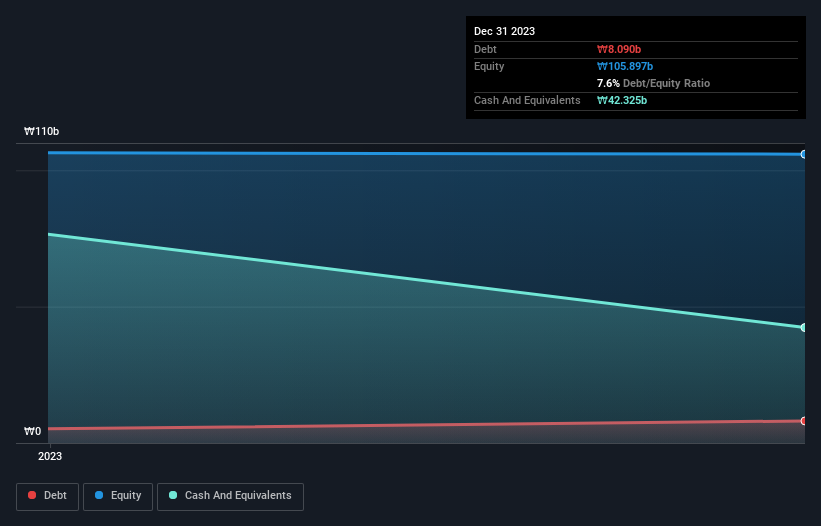- South Korea
- /
- Machinery
- /
- KOSDAQ:A382900
Bumhan Fuel Cell (KOSDAQ:382900) Has Debt But No Earnings; Should You Worry?

The external fund manager backed by Berkshire Hathaway's Charlie Munger, Li Lu, makes no bones about it when he says 'The biggest investment risk is not the volatility of prices, but whether you will suffer a permanent loss of capital.' So it might be obvious that you need to consider debt, when you think about how risky any given stock is, because too much debt can sink a company. We note that Bumhan Fuel Cell Co., Ltd. (KOSDAQ:382900) does have debt on its balance sheet. But should shareholders be worried about its use of debt?
When Is Debt Dangerous?
Generally speaking, debt only becomes a real problem when a company can't easily pay it off, either by raising capital or with its own cash flow. Ultimately, if the company can't fulfill its legal obligations to repay debt, shareholders could walk away with nothing. However, a more usual (but still expensive) situation is where a company must dilute shareholders at a cheap share price simply to get debt under control. By replacing dilution, though, debt can be an extremely good tool for businesses that need capital to invest in growth at high rates of return. The first thing to do when considering how much debt a business uses is to look at its cash and debt together.
View our latest analysis for Bumhan Fuel Cell
What Is Bumhan Fuel Cell's Debt?
As you can see below, at the end of December 2023, Bumhan Fuel Cell had ₩8.09b of debt, up from ₩5.20b a year ago. Click the image for more detail. However, its balance sheet shows it holds ₩42.3b in cash, so it actually has ₩34.2b net cash.

A Look At Bumhan Fuel Cell's Liabilities
According to the last reported balance sheet, Bumhan Fuel Cell had liabilities of ₩10.6b due within 12 months, and liabilities of ₩7.09b due beyond 12 months. Offsetting this, it had ₩42.3b in cash and ₩19.2b in receivables that were due within 12 months. So it can boast ₩43.8b more liquid assets than total liabilities.
This excess liquidity suggests that Bumhan Fuel Cell is taking a careful approach to debt. Due to its strong net asset position, it is not likely to face issues with its lenders. Simply put, the fact that Bumhan Fuel Cell has more cash than debt is arguably a good indication that it can manage its debt safely. The balance sheet is clearly the area to focus on when you are analysing debt. But ultimately the future profitability of the business will decide if Bumhan Fuel Cell can strengthen its balance sheet over time. So if you want to see what the professionals think, you might find this free report on analyst profit forecasts to be interesting.
In the last year Bumhan Fuel Cell had a loss before interest and tax, and actually shrunk its revenue by 40%, to ₩31b. That makes us nervous, to say the least.
So How Risky Is Bumhan Fuel Cell?
Statistically speaking companies that lose money are riskier than those that make money. And in the last year Bumhan Fuel Cell had an earnings before interest and tax (EBIT) loss, truth be told. And over the same period it saw negative free cash outflow of ₩26b and booked a ₩2.4b accounting loss. But at least it has ₩34.2b on the balance sheet to spend on growth, near-term. Even though its balance sheet seems sufficiently liquid, debt always makes us a little nervous if a company doesn't produce free cash flow regularly. The balance sheet is clearly the area to focus on when you are analysing debt. However, not all investment risk resides within the balance sheet - far from it. We've identified 2 warning signs with Bumhan Fuel Cell , and understanding them should be part of your investment process.
When all is said and done, sometimes its easier to focus on companies that don't even need debt. Readers can access a list of growth stocks with zero net debt 100% free, right now.
If you're looking to trade Bumhan Fuel Cell, open an account with the lowest-cost platform trusted by professionals, Interactive Brokers.
With clients in over 200 countries and territories, and access to 160 markets, IBKR lets you trade stocks, options, futures, forex, bonds and funds from a single integrated account.
Enjoy no hidden fees, no account minimums, and FX conversion rates as low as 0.03%, far better than what most brokers offer.
Sponsored ContentValuation is complex, but we're here to simplify it.
Discover if Bumhan Fuel Cell might be undervalued or overvalued with our detailed analysis, featuring fair value estimates, potential risks, dividends, insider trades, and its financial condition.
Access Free AnalysisHave feedback on this article? Concerned about the content? Get in touch with us directly. Alternatively, email editorial-team (at) simplywallst.com.
This article by Simply Wall St is general in nature. We provide commentary based on historical data and analyst forecasts only using an unbiased methodology and our articles are not intended to be financial advice. It does not constitute a recommendation to buy or sell any stock, and does not take account of your objectives, or your financial situation. We aim to bring you long-term focused analysis driven by fundamental data. Note that our analysis may not factor in the latest price-sensitive company announcements or qualitative material. Simply Wall St has no position in any stocks mentioned.
About KOSDAQ:A382900
Bumhan Fuel Cell
Manufactures and sells compressors, fuel cells, and cables in South Korea.
Slightly overvalued with questionable track record.
Market Insights
Community Narratives



